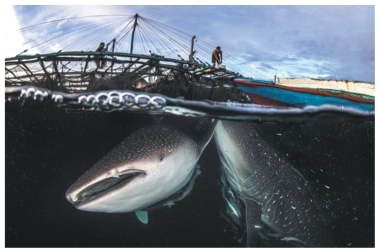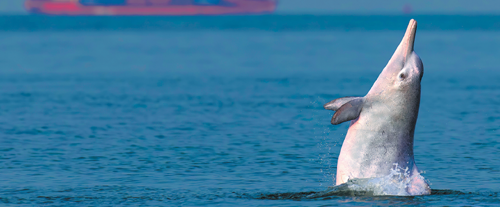Loving Earth through lenses
Photo and video competition utilizes outstanding wildlife images to urge scientific answers and better environmental protection, Yang Feiyue reports.

In the crystal-clear waters of Indonesia's Lembeh Strait, a male jawfish performs one of nature's most touching parental duties — tenderly clutching nearly transparent eggs in his mouth.
The soon-to-hatch eggs reveal tiny embryos, their developing eyes visible through the translucent membranes.
"The jawfish is a small but strikingly colorful marine creature, typically measuring 10-20 centimeters in length. These tropical dwellers favor coral reef environments, where they burrow into sandy substrates or coral debris," says Chen Yihuan, producer of the China Wildlife Image and Video Competition, which kicked off its sixth edition in Foshan, South China's Guangdong province, last month.
The jawfish's characteristic behavior involves peering out from their self-made tunnels, ready to dart back inside at the slightest disturbance — a defense mechanism made possible by their disproportionately large mouths, perfectly evolved for both digging and quick retreat, Chen explains. The photo is on display at the ongoing Beyond Horizon exhibition, which runs until Aug 25 in Nanhai district, Foshan, and showcases the outstanding works from the competition's previous editions.
"What sets these fish apart is their extraordinary paternal instincts. The male jawfish assumes full responsibility for offspring protection, meticulously mouth-incubating the eggs until hatching. Occasionally, he'll gently expel the clutch to clean and aerate them before carefully drawing them back into his oral nursery, which is a remarkable display of underwater parenting highlighting nature's ingenious survival strategies," he explains.
The photo is part of a stunning collection of over 100 iconic nature images, displaying extraordinary moments in the wild — from roaming pods of giant sperm whales and a starfish spawning like a luminous UFO, to playful sea lions interacting with an inflated Arothron meleagris puffer fish in defense mode and a motionless "zombie ant" frozen mid-stride by parasitic fungus on a vibrant leaf.
The exhibition welcomes visitors to view endless variations of nature's timeless themes — survival, reproduction, challenge, adaptation, cooperation, and conflict, notes Chen. The audience can find answers to nature's most compelling mysteries, such as how certain species thrive in the oxygen-deprived heights of the Tibetan Plateau where humans struggle to survive, and how extraordinary forms and survival strategies have evolved in the darkest depths of the ocean.
"To capture these fleeting, extraordinary moments in the planet's most inaccessible realms, wildlife photographers embark on extraordinary journeys. Scaling mountains, braving blizzards, and harnessing cutting-edge technology — all while relying on a stroke of serendipity — they strive to be in precisely the right place at the crucial moment when nature reveals its rarest spectacles," he says.
The competition's sixth edition expects more exciting visual narratives showcasing the resilience and wonders of life in Earth's most extreme environments.
The wildlife competition is the world's first such event initiated by China, and more than 80 countries and regions have participated. The event was invited to appear at the United Nations where it shared China's story of using images to raise awareness of environmental protection.
The year's competition has garnered over 1 billion online views and accumulated more than 60,000 minutes of wildlife footage, with more than 150,000 submissions.
Since its inception, Jane Goodall, a world-renowned primatologist and wildlife conservationist known for her groundbreaking long-term research on chimpanzees, has served as the honorary scientific adviser.
At the competition's launch on May 22, Goodall emphasized in her video speech that "images can sometimes tell a story more powerfully than words" and expressed her hope that more people would become involved in this vital cause.
This edition features 14 categories with 27 awards, including the new "Jane Goodall Youth Award" and "New Discoveries Prize" to empower more creators to "protect nature through lenses," says Li Shuanke, publisher and editor-in-chief of Chinese National Geography.
"Looking back, the first five years of the competition marked a significant milestone. By establishing annual special awards, we have successfully attracted public attention to themes such as China's National Parks, China's Endemic Species, and Human and Nature. These themes reflect the competition's original intention of guiding creative trends in the natural imagery industry," Li says.
This year's theme also revolves around Beyond Horizon, which calls for a renewed focus on the familiar yet often overlooked corners of the natural world to showcase the vibrant force of life presented in the most unexpected places.
"Whether your aspirations lie in far-off lands or the depths of the ocean, Beyond Horizon offers a coordinate, a possibility," Li says.
Xi Zhinong, a respected Chinese wildlife photographer and member of the International League of Conservation Photographers, considers Beyond Horizon "a puzzle that nature has left for us to solve".
"These uncharted territories not only deepen our understanding of biodiversity but also serve as a constant reminder that the mysteries of nature far exceed our imagination," he says.
"As nature photographers, it is our mission to get closer to that mystery, to embark on journeys into areas that have yet to be fully explored. Each time we step into these unknown territories, it feels like a conversation with the unseen," he adds.
When speaking of the meaning of nature photography, the photographer shares his early work filming the golden monkey in southwestern China's Yunnan province.
At that time, there weren't many clear photographs of the species.
His documentary on the golden monkey was one of the first to capture the behavior of these elusive yet rare and critically endangered creatures on film.
"Through our efforts, we raised awareness, which ultimately helped protect the pristine forest where these monkeys live," he says.
The photographer calls attention to the urgency of protecting these areas "beyond the horizon".
"The unknown spaces of our world hold answers not just for science but for the survival of countless species, urging us to act before it's too late."
Hou Mingjuan, vice-president of Qualcomm, a longtime technical partner of the competition, says she is impressed that, apart from professional photographers, people of various ages and backgrounds are getting involved in wildlife photography thanks to continuous technological advancements.
A teenager captured an animal camouflaged in its surroundings during a trip with his mother to Southeast Asia, which ultimately won him a grand prize last year, Hou notes.
"He's an excellent example of how anyone can take out their phone and capture rare or everyday moments, whether it's the growth of endangered species or the small, beautiful moments in our daily lives," she says.
The expanding age demographic and increasingly diverse participant pool contribute to the competition's growing influence, she adds.
Publisher Li believes the ongoing exhibition is a good representation of the competition's value, as the public can "gain a broad and comprehensive view of the diverse landscapes of mountains, lakes and seas, and the vibrant lives within them".
These efforts help awaken the innate love for Earth that lies within every person, he notes.




Today's Top News
- The farmer, the snake and Japan's memory hole
- Crossing a milestone in the journey called Sinology
- China-Russia media forum held in Beijing
- Where mobility will drive China and the West
- HK community strongly supports Lai's conviction
- Japan paying high price for PM's rhetoric






























